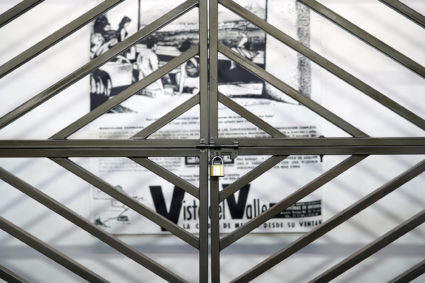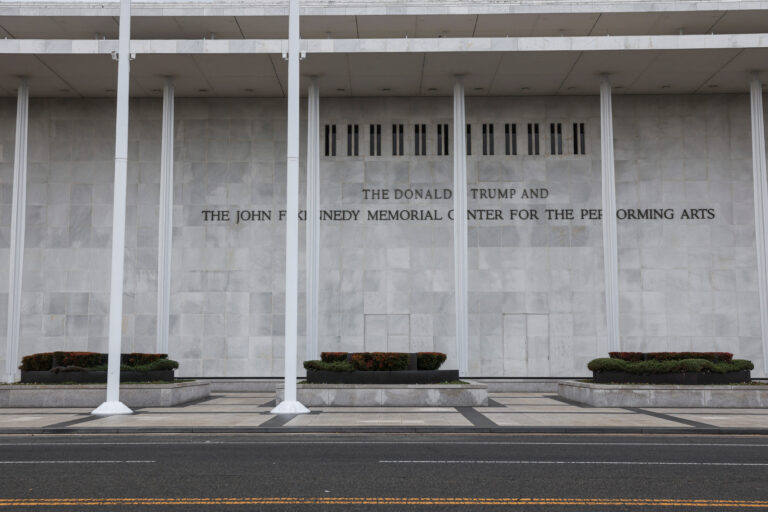
Artist Débora Delmar on the invisible gates that shape us
While artists and gallerists dusted off their artwork and laid out business cards for their booths for the second day at this year's Material Art Fair in Mexico City, there was no one at home at one imposing installation: a tall, metal gate.
If you walked up to that gate, called "Property/Propiedad," that day, you were instead met with two locks that secured two entrances. Standing there felt like waiting two beats too long outside someone's door, without any certainty that they would ever answer.
That day, artist Débora Delmar was tending to an emergency that kept her away from the fair. In a conversation later, Delmar said that the gate was inspired by ones that exist in upper-middle-class housing developments in Mexico City — the gate's lattice pattern mimics one specific gate she saw in Guadalajara, Mexico, years ago.

But a gate, Delmar noted, can also be imaginary.
"A lot of the barriers we encounter aren't necessarily physical," she said.
There was something else imaginary on the other side of Delmar's gate. A fantasy.
Looking through the bars, a black-and-white, hand-painted advertisement — a "rótulo" — sells the idea of an easy lifestyle. Researching for this installation, Delmar found ads from the 1950s and 1960s that advertised three housing developments, which at that time were farther away from the center of Mexico City. Since then, the capital has grown exponentially.

Delmar's recreated ad for the upscale Del Valle neighborhood spotlights the panoramic view you could have of Mexico City. That panoramic view — "el mas hermoso panorama" — is a bragging point, as a cluster of apparent friends and family enjoy the lookout point. In her ad for the Loma del Rio neighborhood, a man — easel in his left hand — is painting outside his home, while his female companion climbs into a luxurious car full of people.
Depending on where you live, even a gate can be considered a luxury. Delmar, a London-based Mexican artist, has often examined how everyday objects can be considered such status symbols. She's also interested in the forces at play — economic, political — that compel us to seek them out.
The key to unlocking the experience of Delmar's installation are literally keys — several sets of keychains that open the gate.
Keychains — like an online profile, mixtape or vision board — may seem trivial, but can reflect our likes and personalities in small, and sometimes contradictory, ways. One of Delmar's installation keychains pairs a cartoon image of Mexican President Andrés Manuel López Obrador with one of the Eiffel Tower. Another puts Betty Boop together with a shiny die.

In seeing Marie, the pink-bowed kitten from Disney's "The Aristocats," paired with the Ferrari logo, it's funny to imagine the person who drives an Italian sports car and is also into Disney films.
Delmar's gate isn't really a didactic statement on late capitalism. Nor does it fully condemn the idea of seeking these pleasures. It reflects the way we're all shaped by our aspirations, and whether we have the keys or not.
The PBS NewsHour spoke with Delmar about Mexico City's changing landscape, the story behind her name — and its connection to a German spy — and what happened when she opened the gate to her installation.
This interview has been edited for length and clarity.
So much of your work deals with class differences or how capitalism fuels the inequality between lower and upper classes. Why is that a focal point in your work?
I grew up in Mexico City, and I grew up in '86. So I was a kid in the '90s, and places like McDonald's and all these kinds of shops that started opening when I was a teenager — Starbucks, etc. — were like a major influence in my upbringing.
This influences part of your everyday life, and in Mexico City, there is a very obvious visual. You can find, like, a really rich neighborhood right next to a very, very poor neighborhood. So this is a contrast of the city, not only economically, but also a class system based on skin color, like where you grew up, where you lived in the city.
I went to school in New York to do my B.A., and I was also really interested in this type of art school in the system of an American school, which was basically a corporation. It was a business that was set up in the middle of Chelsea. That's where I kind of started addressing this subject matter. That's where I began working under the name of Débora Delmar Corp., because I also have a name which sounds fake, and it actually was made up by a German spy who came to Mexico and changed his name to my last name. My identity was already, in a way, a construct, even though it is my real name. (Editor's note: Delmar no longer uses the Débora Delmar Corp. pseudonym, but used it to play with ideas of art and branding.)
Was that part of the story you concocted for Débora Delmar Corp.?
I did not! It's the truth.
What? Tell me more about that.
(laughs) I'm telling you more than you're asking, but basically my great,-great-grandfather was a German spy who came to Mexico. He was Jewish and he came during the First [World War] — This is all the information I have. There are a bit of leaks in the information we have in the family because we haven't been able to find everything. And he married a Mexican woman in Chiapas. And so, he was this German guy who came here and changed his name, had a family and had to flee and then dies in Spain. And obviously, he had to leave because he was a spy. And he left a family, which is very small, and it's very mixed racially as well.
So, hearing about that had an impact on you.
I think it's had an effect on me in terms of my identity. Even, like, Débora is not a Mexican name. I always had this kind of idea of being from here, but not being from here, or having a bit of a mystery about who you are, your identity. I guess we're all in that search, in a way.

You were born and raised in Mexico City. You talked about the juxtaposition you saw in the city. Can you talk about when you first became aware of the city's changing landscape?
I think the first time I saw this was when I was a teenager and Starbucks opened. The first one opened in Mexico City, and I remember my friends and I going there and being super excited about it. And I'm getting like a crazy, sugary Frappuccino.
There's this love-hate relationship with the U.S. and Mexico, and people would travel, no? Like, when you were little, this kind of middle class families, we would be like, "Oh, yeah, let's go to the U.S., go shopping, go to these malls to find these brands that we cannot find here." Over time, you would see more different kinds of — from hotels to restaurants and brands. I mean, nowadays there's more [in Mexico]. It's an ongoing thing.
When you see capitalism at play like that, through your own art, what do you want people to understand about those forces at work?
I think people really demand — or expect — for artists to have like a very defined political stance in what you're doing, and especially in terms of when you're talking about capitalism, and me being Mexican, me being a woman, there's a lot of expectations that their work is very directive on that. But I've chosen actually to play with it. It's more interesting for me to remove myself as a person from it. Obviously, it comes from a personal point of view, but I think more and more, I'm interested in things becoming more abstract because it becomes more poetic. I feel like at the end it's art, and I'm not a politician or an activist, even though I have political views, and I have everyday actions that are interconnected with my views or things that I appreciate, support, etc.

For me, it's not necessarily that I'm making a change through making art. I think it's more just like maybe either incorporating ways of labor and ways of thinking or pointing at certain things, but also kind of creating sometimes an effect on the viewers, creating something that is just not so obvious. I would like for it to also be an experience that takes you beyond a particular, specific thing. Like the gate, for example, that I built for the booth. It's very obviously a gate and it's based on a very specific type of gates in the city, in these gated communities. But a gate has relevance or political relevance, social relevance that can become very international, and we all are experiencing these kinds of issues.
The gate obviously talks about exclusion and inclusion, and inside and outside. I feel like you have a relationship to it. And also it created a very interesting effect today. We opened it, and we've left it open. And it's kind of like, psychologically, who wants to go in and not. There's people that are really scared of going in. It's kind of like an experiment in a way.
You added a barrier that no one else really has in their booth.
Whenever I work, I kind of create projects that are kind of like in relationship to the place I am exhibiting, but also in relation to the situation or location, etc. Last year, I was part of the performance program. I hired a lot of teenagers from a high school, similar to the one that I went to in Mexico, and I brought them here. It was interesting because they weren't performing, I didn't ask them — I gave them agency, but I was obviously with them and gave them certain instructions. But it wasn't a theatrical thing. It was very organic. There were moments where you could tell or not tell what was going on, whether it was a performance or not.
So they weren't relegated to a stage.
No. They were like hanging out in their hangout area or sitting down. They made a circle, sat down on the floor. We had props as well. We had different things they brought with them. It was thinking of my experience in the city, and growing up, going to a shopping mall. I was thinking of the fair as a shopping mall. And then, who do you expect to see at an art fair or not? And what kind of behavior is accepted or not in an art fair? Like, what's your audience? And this being also the young art fair — it brings me back. Me growing up here again. And I think this time, I was thinking: The booth, you pay for per square meter. You know, the galleries have to pay for this property during this period of time. And they become your territory.

Beyond the gate is what I think is a fantasy from these advertisements, and what they're showing. What was your thinking behind those ads in particular?
Those are advertisements I found in the newspaper called Excélsior. And it's been quite interesting because a lot of boomers that are around the fair, are walking around, and they're like, "Oh my God. I remember!" because they were in the newspapers, and they were selling at that time. They would sell these properties for families in this very traditional point of view, like the man who has to buy the land for their family and they're all straight. And they all have children, and they all go to church, and they have the garden. And also, like, a very American dream lifestyle. The city, like every other city, has experienced this kind of effects of gentrification and quick growth and real estate values.
Also, you can see the value of the territories, like the land of that time compared to nowadays, which is incredible, no? Like, what you could afford. I relate to it because we're in this generation where we criticized for — I don't know — people say, like, we invest in avocado toast instead of homes.
I did wonder if you were condemning that fantasy. Condemn may be too strong a word, but I was wondering to what extent it mattered to you to point it out.
For me, it was interesting to see what the values of that era were, and where we stand now. And not necessarily to say it's bad for you to have a family or want to have a house. I'm not condemning — or even a social class — but I do think it's quite interesting to see how society changes and situations that change you as a society as well.
What jump started this idea behind "Property/Propiedad"?
I went to Guadalajara a couple of years ago to do a show. I was walking around these neighborhoods, and then I was like, "Oh my God, these gates are so beautiful." I started explaining to my boyfriend that these are very '70s, of that time in Mexico, where this architecture was very relevant. I really liked the way they also looked like artworks. They're very, very modernist.

So I also think they're really beautiful. I don't just think they're a bad thing, you know? There's a beauty for me that they already have.
As someone who does art around status and how we seek it, is there anything missing from the conversation that needs to be addressed?
The obvious is that those neighborhoods were upper-middle-class neighborhoods. But that is also changing. Mexico and, like, the globally social class is having a shift, no? More and more, this middle class is disappearing. Also something very nice that someone said, was that, yes, we had this illusion of freedom, of looking at the city, of being in this kind of luxury. But actually we put ourselves behind bars.
These kinds of neighborhoods … they do they create a division. They put you in a bubble where you are disconnected from others. You only go out whenever you need.
READ MORE: This artist wants to help you think about your place in the world
Support Canvas
Sustain our coverage of culture, arts and literature.



















